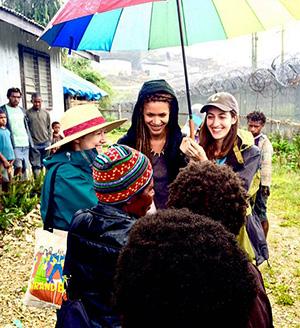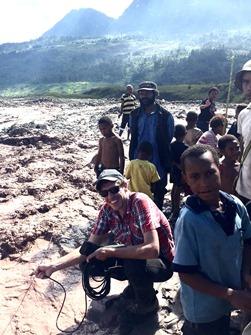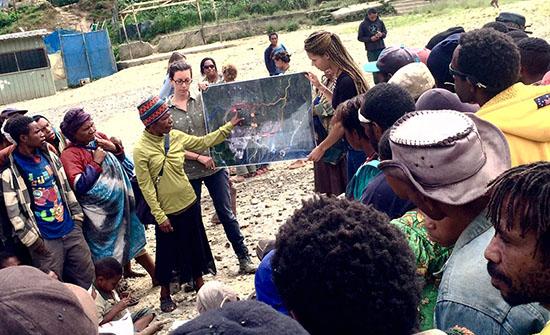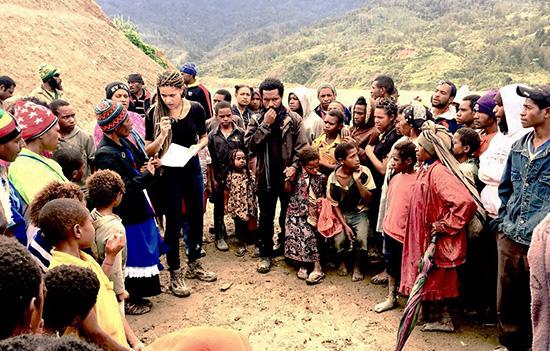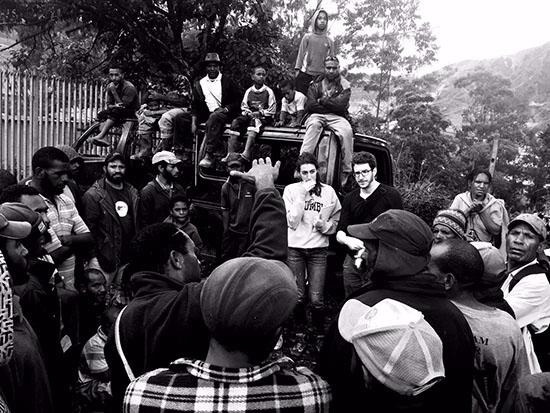Columbia University Team Investigates Sexual Assault and Right to Water in Papua New Guinea
Students And Faculty Traveled To Papua New Guinea To Study The Environmental Impacts Of A Gold Mine And Investigate New Allegations Of Sexual Assault By Security Forces
Over the winter break, an interdisciplinary team from Columbia Law School’s Human Rights Clinic and Columbia University’s Earth Institute returned to the highlands of Papua New Guinea to deliver the results of an independent study of water rights to the
|
Students Lizzie O’Shea LL.M. '16, Candy Ofime '17 and Whitney Hood '16 in Porgera following
discussions with communities about the impacts of mining. |
indigenous communities living near an industrial gold mine. The Human Rights Clinic also investigated new allegations of sexual assault by security forces working around the mine, and held human rights advocacy workshops for women abused by the mine’s staff.
“Many of the villages around the mine are poverty-stricken, overcrowded, and unsafe,” said Professor Sarah Knuckey, the director of the Human Rights Clinic. “Our project blends human rights and science to support indigenous communities impacted by mining in their efforts to advance their fundamental rights.”
The mine, run by Canadian mining company Barrick Gold and Chinese company Zijin, has brought benefits to local communities in the form of improved infrastructure and royalties, but residents have frequently raised concerns about security forces abuses, as well as the mine’s impacts on their water, flora and fauna, air, and general livelihoods. The mine uses a mix of erodible dumps and riverine disposal of tailings, in which mine waste is released directly into the local river system. The river of waste is vibrant red in color, and many local residents use it daily to pan for gold. Communities often report not having adequate information about the risks associated with this industrial waste.
In response to community requests for independent environmental assessment, in 2015 the Columbia team conducted interviews in each community near the mine to understand community views about the environment and how residents interact with potentially contaminated materials. The team then tested water and soil from across the valley to determine whether people could be exposed to heavy metal contamination from the mine.
|
Josh Fisher of the Earth Institute, center, collects water samples from the mine's
tailings waste. |
“When we analyzed the samples, we found that major rivers near the mine have heavy metal concentrations above World Health Organization recommendations for safe drinking,” said Dr. Josh Fisher, the Director of the Advanced Consortium on Cooperation, Conflict, and Complexity (AC4) at the Earth Institute. “In contrast, we did not find evidence that the rainwater people collect for drinking contains heavy metals from mining, although it could be unsafe due to the generally poor sanitary conditions in villages.”
In December 2015-January 2016, the team returned to each village to report the results of the environmental testing, using satellite maps color-coded for water drinking quality, created with project partner and spatial analysis experts Brad Samuels and McKenna Cole of SITU Research.
“By working with scientists and experts in data visualization our team has been able to study and convey complex but critically important information,” said Gulika Reddy LL.M. '16, a human rights lawyer from India. “It is very exciting to work with experts from other disciplines and approach this multilayered issue through various perspectives, allowing a deeper understanding of the issues and improving how information is shared.”
The team met with a wide range of stakeholders on the issue of water in the valley to explore ideas and opportunities for improving water security. While in Papua New Guinea, the team also met with the senior management from the mine to discuss the project, as well as government officials.
| Columbia Law School Professor Sarah Knuckey, center left, and Human Rights Clinic student Candy Ofime '17, center right holding map, discuss water testing results with communities in Porgera, Papua New Guinea. |
“We worked in the villages in and around the mine every day, and you can smell the chemicals, feel the dust in the air, and see a white cloud rising from the mine’s mill,” said Candy Ofime ’17, who was the clinic’s student lead on the right to water study. “It’s no wonder that residents are concerned. Most lack access to information and want to be relocated away from the mine. We returned this year to discuss the results with local residents, and to discuss community recommendations for improving their rights to water.”
The team will issue reports on the environmental assessment and right to water later this year, including recommendations to improve conditions around the mine. The team is also working with SITU Research to create an interactive online platform to share the results.
The Human Rights Clinic was also in Porgera to continue its long-term work on security force violence and corporate remedies for rape.
| Human Rights Clinic student Candy Ofime '17 consults with communities in Porgera about the right to water and recommendations to improve water security. |
Last year, the Human Rights Clinic issued a major report on rape and gang rape by the mine’s security forces and the mining company’s response to those assaults, which included the creation of a novel remedy mechanism. The team presented the report -- Righting Wrongs? Barrick Gold’s Remedy Mechanism for Sexual Violence in Papua New Guinea – at the United Nations, following a multi-year intensive investigation and consultations with Porgeran women, and received detailed press coverage.
“The remedy mechanism was deeply flawed,” said Whitney Hood ’16, who worked on the report, and joined the team in Porgera to discuss the report with sexual assault survivors. “The company ignored allegations for far too long, and the mechanism was quite poorly implemented, in part because Barrick failed to consult directly with survivors. The company did not adequately address what is a significant power imbalance between a multinational corporation and the local women, many of whom do not speak English and are not able to read and write.”
While in Porgera, the team reported back to the women about the report and sought their views about future advocacy plans. The women are actively organizing to secure their rights.
“The women’s determination is inspiring and impressive,” said Lizzie O’Shea, LL.M. ’16, a human rights lawyer from Australia who helped run the workshops in Porgera. “We look forward to assisting them in their efforts to advance their fundamental rights this coming semester.”
| Human Rights Clinic student Whitney Hood '16, center left, and Clinic Fellow Benjamin Hoffman, center right, speak with residents of Porgera. |
The team also investigated a number of new alleged cases of serious abuse, including of three men, one of whom is HIV positive, forced to rape each other, as well as women raped by government security forces working at and around the mine.
“After investigating, we presented these cases to the company, and senior police and oversight officials,” said clinic fellow and lecturer Benjamin Hoffman. “We expect to see rigorous investigations and efforts to hold those responsible accountable.”
Knuckey has been working in Porgera for the last decade with Clinic students. Canadian company Barrick Gold has run the mine for nearly a decade, and the mine has been operating since 1989. Clinic involvement began when local residents reported that mine security staff were repeatedly engaged in assaults. At the request of local communities, clinic work expanded to include examination of environmental issues.
# # #
The Human Rights Clinic is an intensive year long course directed by Sarah Knuckey, the Lieff Cabraser Heimann and Bernstein Clinical Associate Professor of Human Rights and the faculty co-director of the Human Rights Institute at Columbia Law School, as well as by Clinic Fellow Benjamin Hoffman. The Clinic brings together human rights work, student education, critical reflection, and scholarly research. Students are trained to be strategic human rights advocates, while pursuing social justice in partnership with civil society and communities, and advancing human rights methodologies and scholarship.
The Earth Institute, founded in 1997, leverages the expertise of its 30 research centers and 850 scientists, postdoctoral fellows and staff at Columbia University to generate solutions for sustainable development. This unique institute brings together the intellectual, practical and theoretical resources needed to address some of the world’s most difficult problems including environmental sustainability, climate change and poverty. Inside The Earth Institute, The Advanced Consortium on Cooperation, Conflict and Complexity (AC4) works to bring sustainable solutions to the issues of violent conflict, peace and sustainable resource management.
